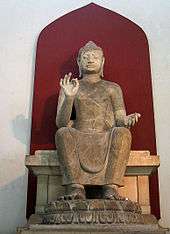OK gesture
The OK or ring gesture (Unicode symbol U+1F44C "👌") is performed by connecting the thumb and index into a circle, and holding the other fingers straight or relaxed away from the palm. Commonly used by divers, it signifies "I am OK" or "Are you OK?" when underwater. In most English-speaking countries it denotes approval, agreement, and that all is well or "okay". In other contexts or cultures, similar gestures may have different meanings or connotations including those that are negative, offensive, financial, numerical, devotional, political,[1] or purely linguistic.
_hand_only.jpg)

Positive connotations
Classical use
Ring gestures, formed by forefinger and thumb with remaining digits extended, appear in Greece at least as early as the fifth century BCE, and can be seen on painted vases as an expression of love, with thumb and forefinger mimicking kissing lips. When proffered by one person toward another in Ancient Greece, the gesture was of one professing their love for another, and the sentiment was conveyed more in the touching of fingertips than in the ring that they formed.[2] As an expression of assent and approval, the gesture can be traced back to first century Rome where the rhetorician Quintilian is recorded as having used it.[3] Quintilian's chironomy prescribed variations in context for the gesture's use during specific points of a speech: to open, give warning or praise or accusation, and then to close a declamation.[2]
Contemporaneously the sign appeared throughout the Buddhist and Hindu diasporas as a symbol of inner perfection. Ethologist Desmond Morris posits that the joined thumb-and-forefinger communicates precision in grasping something literally or figuratively, and that the shape formed by their union represents the epitome of perfection—a circle—hence the gesture's transcultural message that things are "exactly right" or "perfect".[4]
In Naples the gesture has been long used to symbolize love and matrimony, as was custom in neighboring Greece, but specifically with the palm upturned, while the gesture made with a downturned palm represents a hand holding the scales of justice.[2][5] Across Italy the gesture remained in use as one for making points in conversation when moved about to express discursive precision, but when held still in an upright position with fingers jutting skyward, it became an emblem of perfection.[2]
Early records of the sign's usage in the English-speaking world date to British physician-philosopher John Bulwer's 1644 Chirologia, "The naturall language of the hand composed of the speaking motions, and discoursing gestures thereof."[6] Among the many hand gestures detailed by Bulwer, he described one as "The top of the fore-finger moved to joyne with the naile of the Thumbe that's next to it, the other fingers in remitter,"[7] and said that it was "opportune for those who relate, distinguish, or approve".[8]
"OK"
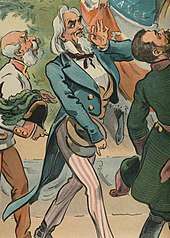
By the early 19th century in the United States, the gesture was affiliated with the letters "O" (formed by the circle) and "K" (derived from the extended fingers). While it is not known exactly how the OK gesture and the corresponding verbal expression coalesced, the English professor Allen Walker Read dates the expression's rise in usage to an 1839 humor piece in the Boston Morning Post describing the expression "o.k." as meaning "all correct", suggesting comically misspelled initials, at a time when acronyms for misspelled words were in vogue.[9] Several other broadsheets in Boston, New York and Philadelphia ran with the expression in their own columns, some with misspellings of "all correct" such as oll korrect, bringing the phrase into the vernacular of American English.[10]
The following year Democrats took to using the phrase and its accompanying gesture in support of president Martin Van Buren's campaign for reelection. A native of Kinderhook, New York, Van Buren was widely known by his nickname, "Old Kinderhook", whose initials, "O.K.", were steadily gaining traction as an expression of approval.[11] In New York City, fans of Van Buren formed the O.K. Democratic Club and used the gesture as its sign, with the slogan of "O.K." bearing the double meaning in the club's catchphrase, "Old Kinderhook is all correct."[10] Both phrase and gesture made their way into newspapers around the country via political cartoons, thus further spreading the expression. After Van Buren's defeat to William Henry Harrison, O.K. was briefly satirized as meaning "Ofrul Kalamity" or "Orful Katastrophe".[12]
Despite Van Buren's loss and the subsequent dissolution of the O.K. Democratic Club, the gesture has since been widely used since to mean "all is well" or "good" in the United States.[13][14] As a gesture, its connotation is more positive than the word "OK", which may mean a thing is merely mediocre, satisfactory at only the most basic level, as in, "The food was OK." The gesture is commonly understood as a signal of approval,[11] and is sometimes used synonymously with the Western "thumbs up" gesture.
Scuba diving
_Rick_West_and_divers_from_Southwest_Regional_Maintenance_Center_conduct_pre-dive_checks%3B_hand_signal_%22OK%22.jpg)
In the communication used by scuba divers, the OK sign is specific in its meaning that "everything is OK" as regulated by the Recreational Scuba Training Council. Divers are taught to always use this sign and not the thumbs up gesture because the latter means that a diver needs to ascend.[15] The gesture is also used as a means of checking in, with one diver using it to ask another, "Everything OK?" and the response meaning, "Yes, everything is OK."[16]
At distances where the standard OK gesture may be hard to see, divers use larger signals as an alternative, either with one hand atop the head and the elbow bent out to the side, or with both hands touching above the head so that the arms form an "O" for "OK".[17] This full-body gesture is also used as "OK" in Japan where the single-handed gesture connotes monetary transactions instead of meaning "OK".[18] This two-armed OK gesture was added to Unicode in 2010 under the name "Face With OK Gesture" (U+1F646 "🙆") and became part of Emoji 1.0 in 2015.[19]
Money
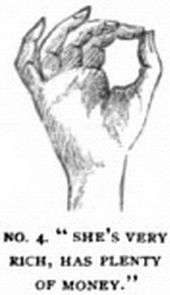
In Japan, the one-handed ring gesture is used to symbolize money,[20] and in this context the fingers' circular shape represents a coin.[4] Sometimes the sign is used to avoid the verbal awkwardness in talking about or asking for money.[21] In other contexts, it can be used to imply a bribe or other illicit financial transactions,[22][23] or signal an invitation to enter into business negotiations.[24]
In other parts of the world the gesture can also express money, financial transactions, wealth or the priciness of an item. Records of the gesture being used to remark on a person's wealth or status are documented as practiced in Mexico during the late nineteenth century.[25]
Mudra
In yoga the gesture is known as chin mudra ("the seal of consciousness") when the palm is face down, or jnana mudra ("the seal of wisdom") when the palm is face up or held in other positions, such as in front of the heart. Some schools of yoga use chin and jnana mudra interchangeably, while others claim that "the former produces a subtle feeling of rootedness, the latter a sense of lightness,"[26] or that jnana "the passive receiving position" while chin "is an actively giving position".[27] In these mudras the middle, ring, and little fingers represent the three gunas of rajas, tamas, and sattva which, when in harmony, unite ātman and brahman, or the individual soul and universal soul. The pressing together of the thumb and forefinger represents that union—or "yoga"—of consciousness.[26] In Buddhism the gesture is called vitarka mudra ("the seal of discussion") and is used to emphasize the meaning of words.[27]
Negative connotations
Cultural contexts

While widespread use of the OK gesture has granted it an international connotation of assent, it also bears negative, vulgar, or offensive meanings in many regions of the world.[28] In contrast to Japan's use of the expression to represent coins and wealth, the gesture's "O" shape stands for "zero" meaning "worth nothing" in France and Tunisia.[23][29] In many Mediterranean countries such as Turkey, Tunisia, and Greece, as well as in the Middle East, parts of Germany, and many parts of Latin America, the gesture may be interpreted as a vulgar expression resembling a human anus, referring to sex, either as an insult ("You are an asshole"), or a homophobic reaction to a symbol of homosexuality and the act of sodomy.[11] In Brazil it can be synonymous with giving someone the middle finger.[30][31]
In Kuwait and other parts of the Arab world, this sign represents the evil eye and is used as a curse, sometimes in conjunction with verbal condemnation.[32][33][34]
In some regions of the world, both the positive "OK" and the negative forms are practiced, which can lead to confusion over which meaning is intended.[11] In regions and cultures where the gesture has a historically negative connotation, its use as an "OK sign" is often the result of its appearance in media and tends to be used more by younger people.[35] In France, where widespread use has seeped in through American culture, the gesture's positive "OK" sentiment became popular in the north of the country while its negative connotation as "worthless" remained in the south. To avoid confusion, French communicators have become accustomed to using additional context clues, such as posture or facial expression, to clarify meaning.[4] In other circumstances, the gesture's varied meanings are less easily reconciled, as was the case in 1950s Brazil when United States Vice President Richard Nixon emerged from his airplane displaying the sign with each hand.[23] While Nixon's intent was to communicate good will to the people of São Paulo, the crowd received it with offense.[36]
The circle game
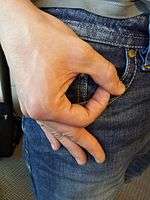
Since the 1970s, the OK gesture has been the key feature of the popular school prank, "the circle game". A person initiating the game makes the gesture palm-inward below their own waistline and tries to trick an opponent into looking at it. If the person looks at it, the maker of the gesture punches the opponent in the arm.[37] Variations exist where a player who can insert their own index finger into the circle without looking at it may punch the circle-maker.[38] In November 2000, the gesture gained widespread use when the circle game was a plot feature in an episode of the sitcom Malcolm in the Middle.[39] In a much earlier version (1950s), the circle was placed over the maker's elbow, or any body part.
White power symbol
In 2017, users on the message-board site 4chan[40][41][42] aimed to convince the media that the OK gesture, or the upside-down version of it, was being used as a white power movement symbol.[40][43] According to The Boston Globe, users on 4chan's /pol/ ("Politically Incorrect") board were instructed in February 2017 to "flood Twitter and other social media websites...claiming that the OK hand sign is a symbol of white supremacy," as part of a campaign dubbed "Operation O-KKK".[37]
The association of the gesture with white supremacy derived from the assertion that the three upheld fingers resemble a 'W' and the circle made with the thumb and forefinger resemble the head of a 'P', together standing for "White Power" (when performed with right hand).[44] While some members of the alt-right used the symbol after the launch of the 4chan campaign, it initially remained ambiguous whether or not it was being used to communicate genuine adherence to white supremacy, or with deliberately ironic motives.[45] The Anti-Defamation League (ADL) wrote in May 2017:
Has the simple thumb-and-forefinger 'OK' hand gesture become a common white supremacist hand sign? Not quite, but it has become a popular left hand gesture used by people across several segments of the right and far right—including some actual white supremacists—who generally use it to trigger reactions. [...] Only if the gesture occurs with left hand in context with other clear indicators of white supremacy can one draw that conclusion.[44]
In September 2019 the ADL changed its position, adding the OK gesture to its "Hate on Display" database.[46] According to the ADL, by 2019 some white supremacists had begun using the OK symbol "as a sincere expression of White Supremacy". Many white supremacists have acknowledged using the left hand symbol as a gesture of White Power.[40] A number of people have been accused of genuine use of the sign in support for white-supremacist ideology:[37][47][48]
- In April 2017, men's-rights blogger and political commentator Mike Cernovich made the gesture while posing for a picture at the White House.[47]
- In July 2018, four police officers in Jasper, Alabama were suspended for a week for making the gesture in a surreptitious palm-inward manner similar to the circle game, but in the context of posing for a group photo.[45]
- In September 2018, the U.S. Coast Guard disciplined an employee who conspicuously made this gesture in the background of a newscast.[49][43]
- In March 2019, Idaho Lt. Governor Janice McGeachin received considerable criticism for posing with members of the 3 Percenter right-wing militia group outside of her office who made the palm-inward gesture.[50][51][52]
- In March 2019, terrorist Brenton Tarrant flashed the sign to cameras in a New Zealand courtroom during his arraignment for the fatal shooting of 50 people in the Christchurch mosque shootings.[53][54][41]
- In May 2019 a Chicago Cubs fan was banned from Wrigley Field for using the gesture behind black commentator Doug Glanville during a TV report.[55]
- In May 2019, Chicago's Oak Park and River Forest High School spent $53,000 to reprint its yearbook after 18 students showed the OK sign in pictures. School officials stated that the symbol's association with white supremacy could jeopardize the students' reputations and future college and job prospects, so they would be removing the photographs from the yearbook in its reprinted form.[56]
- In October 2019, an actor portraying the character Gru from Despicable Me was also banned and fired at Universal Orlando, for displaying the gesture in a photo with a biracial girl. The photo showed the costumed actor standing behind the girl while making the OK gesture on her shoulder.[57][58]
- In January 2020, the perpetrator of the Bærum mosque shooting flashed the Nazi salute and the OK hand sign during a court hearing.[59] He repeated the use of the sign at the start of his trial.[60]
Sign language
Most sign languages combine hand shapes, movement, and position in relation to the rest of body, as well as additional body language and facial expression. As with other hand signs, the OK gesture may be combined with other elements to convey numerous meanings across multiple sign languages.
Monastic signing
Dating back to the tenth century in Europe, the gesture of thumb and forefinger forming a ring with the remaining fingers extended was used in a set of standardized ecclesiastical signs employed by Christian monks under vows of silence to represent numerous religious rites and objects. For example, when held out in front of oneself the gesture represented an oblation to God. When touched to the mouth it meant taking a meal. When added to the open-palmed sign for 'book' it specified a hymnal, and the sign's O-shape represented the signing of an 'O' that began many hymns. If the thumb and forefinger took hold of a specific part of one's own clothing or body such as the hood of a cowl, a lock of hair, or skin on the left hand, the gesture could stand for things as diverse as 'monk' or 'horse' or 'parchment'.[61]
Plains Indian Sign Language
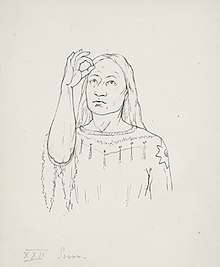
In North American Plains Indian Sign Language (PISL), the gesture signifies the Sun when held up in front of the face or moved in an arc following the Sun's track. When held up to the sky and peered through, it is the sign for high noon.[62] A PISL primer printed in an 1888 issue of the Canadian residential school newspaper Our Forest Children specifies that the left hand be used to indicate sunrise and the right for sunset.[63] A more complicated series of movements with hands held in the gesture as if drawing a thread or stretching an elastic can signify death, or more specifically, 'After a long time, you die.'[64]
American Sign Language
In modern-day American Sign Language (ASL) the gesture can mean many different things depending on how it is applied. The pinching action of the thumb-and-forefinger frequently represents something small. For example, the sign for 'housefly' is made by making the gesture mimic a fly buzzing around.[65] In ASL the gesture can also communicate a selection of some sort: When moved from one side to the other as if picking something up and placing it down, it means 'appoint'. When the joined thumb and forefinger of the gesture are placed into a hole made by the opposite hand, it means 'vote'. The sign for 'elect' is formed by making the signs for 'vote' and 'appoint' in succession.[66]
Fingerspelling

In deaf culture, the sign of joined thumb and forefinger takes on various letters in different systems of fingerspelling. The American manual alphabet reserves it for the letter F, while in both Irish and French Sign Language it is the letter G.[67] In fingerspellings that represent Cyrillic alphabetical systems, such as the Ukrainian manual alphabet, the gesture represents the vowel O and reflects that letter's shape.[68] Similarly, the Korean manual alphabet uses the gesture for the Hangul letter "ㅇ", romanized as "ng" to reflect its pronunciation in spoken Korean.[69] In yubimoji (指文字 ), Japan's manual syllabary whose 45 signs and four diacritics represent the phonemes of the Japanese language, the gesture is the syllable "me" (め in hiragana, メ in katakana).[70] Various fingerspelling systems may call for other specific features of the gesture beyond its joined thumb-and-forefinger with remaining fingers entended. For example, the ring in yubimoji's "me" gesture is slightly tapered rather than rounded.[71]

Counting
In American Sign Language the OK gesture represents the number 9 when held in a stationary position with the palm facing away from the signer.[72] This ASL numerical sign is the last in a sequence of single-digit integers where quantities of fingers denote the numbers 1 through 5, and then the thumb touches each finger in turn to denote '6' (pinky finger), '7' (ring finger), '8' (middle finger), and finally '9' (index finger). When shaken from left to right, the sign for the number 9 becomes the number 19.[72]
In Plains Indian Sign Language, the gesture signifies the number 3 when held a bit lower than the signs used to represent the sun.[64] Regional forms of finger counting used in China also employ the raised middle, ring and pinky fingers to express the number 3, either with thumb and index fingers joined as they are in the OK gesture or in a similar configuration.[73] This number gesture is primarily used in China's southern provinces, while in the north, '3' may also be expressed by the raised index, middle, and ring fingers as it is in English-speaking countries.[74] Both methods are distinct from having the thumb, index and middle fingers extended as is used to denote '3' in much of mainland Europe,[75] because this represents the number 8 in both Taiwan and parts of mainland China.[76]
Greco-Roman chironomia also included a counting system in which the ring gesture stood for either '10', '30', '100', or '300', the exact number being determined by which hand was used and the exact point of contact between thumb and forefinger.[5]
Popular culture
The Prisoner
The gesture was given prominence in the 1967 British television series The Prisoner, in which a number of unnamed characters are held captive in a village.[77] Whenever these imprisoned villagers took leave of each other, they did so with the phrase "Be seeing you", accompanied by the gesture held up in front of their own eye as a reminder that despite any pretenses of freedom, they were all prisoners.[78] The gesture is also used as a greeting in the show without the "be seeing you" phrase. The series' lead actor Patrick McGoohan stated that the show had adopted the gesture from the sign of the fish used by early Christians.[79][80]
As a film title
In 2010, South Indian film director Upendra Rao made a cinematic comeback with a film that fans called Super, but whose actual title was 👌.[81] Rao himself starred in his film as a non-resident Indian who returns to his homeland to turn the nation into a utopian society.[82] In depicting the film's title only as a hand symbol, Rao's intent was for the audience to name it, thinking that they might call it "Zero" or "Three", or associate it with Vitarka Mudra or the symbol for om (ॐ).[83] During the film's opening credit sequence, the Vitarka Mudra title transforms into a hand pointing at the viewer announcing the name of the director as "U".[84]
Other connotations
Political affiliations
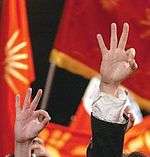
In Europe's Balkan region, the OK gesture is known as the United Macedonia Salute in its association with irredentist campaigns for a united Macedonia.[85] For Macedonian nationalists the two fingers forming the "O" stand for the Macedonian word Обединета (Obedineta, meaning "United"), and the other three fingers symbolize the regions of Aegean Macedonia in northern Greece, Pirin Macedonia in southwestern Bulgaria, and the region of Vardar Macedonia that roughly corresponds to the Republic of North Macedonia's 21st century borders.[86] Taken together, the United Macedonia Salute also resembles the Vergina Sun that was the royal symbol of Ancient Macedonia. Both Sun and Salute became popular among Macedonian Greeks in the 1980s, and the Sun appeared on the Macedonian flag after the Republic of Macedonia declared independence from Yugoslavia in 1992. Three years later Macedonia changed its flag under economic pressure from Greece, which saw the use of the Vergina Sun as a threat against Greek sovereignty. The United Macedonia Salute remains controversial among many people in the Balkan region, especially those living within parts of Greece or Bulgaria that Macedonian nationalists wish to claim as provinces for the Republic.[87]
Medical testing
The gesture is used by doctors to test functionality of the anterior interosseous nerve and seek indications of median nerve palsy in the hands. When performing the test, a patient makes the OK gesture with both hands. If the circle formed by one hand appears more pinched or less round than the other, it may indicate weakness in the nerve.[88][89]
A similar medical test, known as Froment's sign, is used to test for palsy on the ulnar nerve. To perform the test, a patient holds a piece of paper between their forefinger and thumb, and the examiner attempts to pull it out of the patient's grip.[90] If ulnar nerve palsy is present, the patient will have difficulty maintaining their hold and may compensate by flexing the thumb to add more pressure.[91]
Corporate logos
The gesture has been used as a design element in several corporate and organizational logos. These include the Piramal Group, Bharat Petroleum, and Adlabs Studios, all headquartered in India.[92] Piramal Group CEO Ajay Piramal told the press that "The Group's values are rooted in tradition. They have been derived from three guiding principles in the Bhagavad Gita: Gyan Yoga (the principle of knowledge and learning), Karma Yoga (the principle of dynamic action and entrepreneurial spirit) and Bhakti Yoga (the principle of care, compassion and devotion to a higher purpose)." Piramal stated that the three fingers in the logo symbolize the mind, the body and the intellect in alignment with the Group's core values of "Knowledge, Action and Care" that subtitle the corporation's logo.[93] In contrast to this, Bharat Petroleum began using the OK gesture as its own logo in 2002 with its "Pure for Sure" initiative to indicate that petrol filling stations and trucks transporting gasoline had been audited and approved as selling pure, undiluted fuel, and that customers could trust that what they were buying had been "okayed".[94]
See also
- Okay
- A-ok
- Thumb signal
- Three-finger salute (disambiguation)
References
- "Is that an OK sign? A white power symbol? Or just a right-wing troll?". Southern Poverty Law Center. Retrieved 17 August 2019.
- Müller, Cornelia; Cienki, Alan; Fricke, Ellen; Ladewig, Silva; McNeill, David; Tessendorf, Sedinha (2014). "114: Ring-gestures across cultures and times: Dimensions in variation". Body – Language – Communication. Walter de Gruyter GmbH & Co KG. pp. 1511–1522. ISBN 9783110302028.
- Tuleja, Tad (2012). "2. In the Wink of an Eye: Gestures and Posture". Curious Customs. Stonesong. ISBN 9780985434397.
- Morris, Desmond (2012). Peoplewatching: The Desmond Morris Guide to Body Language. Random House. pp. 49–52. ISBN 9781407071497.
- Elworthy, Frederick Thomas (1895). "V11: Touch, Hands, Gestures". The Evil Eye: An Account of this Ancient and Widespread Superstition. J. Murray. pp. 233–276.
- Bulwer, John. "[TCP] Chirologia, or, The naturall language of the hand composed of the speaking motions, and discoursing gestures thereof : whereunto is added Chironomia, or, The art of manuall rhetoricke, consisting of the naturall expressions, digested by art in the hand, as the chiefest instrument of eloquence, by historicall manifesto's exemplified out of the authentique registers of common life and civill conversation : with types, or chyrograms, a long-wish'd for illustration of this argument". Oxford University Text Archive. Oxford: University of Oxford. Retrieved 10 January 2019.
- Merz, Andreas (14 October 2010). "Embleme im interkulturellen Vergleich: Eine Untersuchung zur Bedeutung von 16 Emblemen in Kolumbien und Deutschland" [Emblems in intercultural comparison: An investigation of meaning of 16 emblems in Colombia and Germany] (PDF) (in German). Leipzig: Institut für Angewandte Linguistik: 73. Archived from the original (PDF) on 11 January 2019. Retrieved 10 January 2019. Cite journal requires
|journal=(help) - Chetwynd, Josh (2013). "Okay Sign". The Book of Nice: A Nice Book about Nice Things for Nice People. Workman Publishing. pp. 36–40. ISBN 9780761172949.
- Oktent, Arika (11 April 2013). "What's the Real Origin of "OK"?". Retrieved 20 November 2018.
- Klein, Christopher (23 March 2014). "The Birth of OK, 175 Years Ago". History. Retrieved 20 November 2018.
- Armstrong, Nancy; Wagner, Melissa (2003). Field Guide to Gestures – How to Identify and Interpret Virtually Every Gesture Known to Man. Quirk Books. ISBN 978-1-931686-20-4.
- Ciardi, John (9 March 2006). "Martin Van Buren Was OK" (Radio). NPR.org.
- Knapp, Mark L.; Hall, Judith A. (2009). Nonverbal Communication in Human Interaction. Cengage Learning. p. 225. ISBN 978-0495568698.
- Manusov, Valerie; Patterson, Miles L. (10 August 2006). The SAGE Handbook of Nonverbal Communication. SAGE. p. 221.
- Llewellyn, Stevan (7 April 2017). "Scuba Diving Hand Signals Every Diver Should Know". Sport Diver. Retrieved 19 September 2018.
- Mezcua, Jorge (12 September 2013). "Diving signs you need to know". ForDivers.com. Retrieved 4 January 2019.
- "Minimum Course Content for Common Hand Signals for Scuba Diving" (PDF). Recreational Scuba Training Council, Inc. (RSTC) (Jacksonville, FL., USA). 1 December 2005. Retrieved 18 September 2018.
- Lewis, Philip (2 February 2016). "6 Emojis That You've Been Using Wrong, And What They Actually Mean". Retrieved 19 November 2018.
This emoji, which some assumed to be a ballerina performing a dance move, was intended to be used to signify an 'OK' gesture. 'It's supposed to be an OK symbol...The girl's arms are above her head because she's making an OK sign with her whole body (i.e. a circle, or large 'O'), which is a Japanese gesture.' Unicode lists the emoji as face with OK gesture.
- "Face With OK Gesture Emoji". Emojipedia. Retrieved 19 November 2018.
- Parhizgar, Kamal Dean (2002). Multicultural Behavior and Global Business Environments. New York: Routledge. p. 382. ISBN 9781135187132.
- Kasschau, Anne; Eguchi, Susumu (2015). Using Japanese Slang: This Japanese Phrasebook, Dictionary and Language Guide Gives You Everything You Need To Speak Like a Native!. 192: Tuttle Publishing. ISBN 9781462910953.CS1 maint: location (link)
- Nafziger, James A. R.; Paterson, Robert Kirkwood; Renteln, Alison Dundes (2010). Cultural Law: International, Comparative, and Indigenous. Cambridge University Press. p. 133. ISBN 9781139489324.
- "What's A-O.K. in the U.S.A. Is Lewd and Worthless Beyond". The New York Times. 18 August 1996. Retrieved 15 November 2018.
- "Cuidado com os gestos, eles podem representar outra coisa | DW | 5 September 2017". DW.COM (in Portuguese). Deutsche Welle.
O que em lugares da Europa significa 'muito bem!', na América Latina, Grécia, Rússia ou Espanha é um gesto obsceno. Na Tunísia, é xingar alguém de "nulidade". Já para executivos no Japão, significa 'vamos falar de negócios.'
- Iglehart, by Fanny Chambers Gooch (1997). "VII. The Mexicans in their Homes". Face to Face with the Mexicans. New York: Fords, Howard, & Hulbert. p. 211.
- Carroll, Cain; Carroll, Revital (2013). Mudras of India : a Comprehensive Guide to the Hand Gestures of Yoga and Indian Dance (Expanded ed.). Singing Dragon. ISBN 978-1848191099.
- Hirschi, Gertrud (2016). Mudras: Yoga in Your Hands. Weiser Books. pp. 139–141. ISBN 9781609250584.
- Dangerous Body Language Abroad, by Matthew Link. Posted 26 July, 2010 01:00 PM. Retrieved on 26 July 2017
- Merritt, Anne (22 September 2010). "10 common gestures easily misunderstood abroad". Matador Network. Retrieved 17 September 2018.
- Cameron, Tim (4 June 2008). "7 Innocent Gestures That Can Get You Killed Overseas". Cracked.com. Retrieved 15 November 2018.
- Freny (5 July 2016). "4 weird unspoken laws in foreign lands! | Chill Feel". ChillFeel. Archived from the original on 15 November 2018. Retrieved 15 November 2018.
- "Gestures, Arab Culture" (PDF).. GlobalSecurity.org
- Medhat, Noha (22 November 2015). "8 normal signs and gestures that can be offensive in the Middle East". StepFeed. Retrieved 25 February 2019.
The 'OK': The sign is considered very insulting in Turkey and in some other Middle Eastern countries – such as Kuwait – where it denotes the evil eye.
- Ramankutty, P. V. (1999). Curse as a Motif in the Mahābhārata. Nag Publishers. ISBN 9788170814320.
The Western 'A-Ok' sign is, to the Arab, a sign of the evil-eye and used only in conjunction with curses.
- "The That means of the OK Hand Gesture Across the World – Study the That means of Hand Gestures | Turkey To Travel Tour". Turkey To Travel. 27 September 2016. Retrieved 17 November 2018.
- Axtell, Roger E. (1999). Do's and Taboos of Humor Around the World: Stories and Tips from Business and Life. Wiley. p. 92. ISBN 9780471254034.
- Brodeur, Michael Andor (20 September 2018). "That hand symbol you're seeing everywhere? Not OK". The Boston Globe. Retrieved 30 September 2018.
- Bish, Joe (29 June 2017). "Searching for the Man Behind 'The Circle Game'". Vice. Retrieved 18 January 2018.
- Smithers, Dominic (14 November 2018). "'Malcolm In The Middle' Circle Game Episode Aired 18 Years Ago Today". www.ladbible.com. Retrieved 25 February 2019.
- "When is the 'OK' gesture not OK?". BBC News. 16 May 2019.
- "Okay Hand Gesture". Anti-Defamation League. Retrieved 17 July 2019.
- Neiwert, David (19 September 2018). "Is that an OK sign? A white power symbol? Or just a right-wing troll?". Hatewatch. Southern Poverty Law Center.
- Shannon, Joe (15 September 2018). "Coast Guard member reassigned after he flashed 'offensive' hand gesture on TV". USA Today.
- "How the 'OK' Symbol Became a Popular Trolling Gesture". Anti-Defamation League. 1 May 2017.
- Lybrand, Holmes (17 July 2018). "Fact Check: Were Four Police Officers Suspended for Alleged White-Power Gesture?". The Weekly Standard.
- "The 'OK' Hand Gesture Is Now Listed As A Symbol Of Hate". NPR.org. 26 September 2019. Retrieved 5 December 2019.
- Shugerman, Emily (29 April 2017). "Two members of alt-right accused of making white supremacist hand signs in White House after receiving press passes". The Independent.
- Meckler, Laura (12 November 2018). "Apparent Nazi salute in Wisconsin prom photo prompts outrage". The Seattle Times.
- Telford, Taylor; Rosenberg, Eli (14 September 2018). "A Coast Guard officer on Florence duty made a hand gesture on TV. Some saw a white-power sign". The Washington Post. Retrieved 25 November 2018.
- Sewell, Cynthia (1 March 2019). "Lt. Gov. Janice McGeachin facing public condemnation over photo with 3 Percenters". Idaho Statesman. Retrieved 1 March 2019.
- Dawson, James; Druzin, Heath (1 March 2019). "Idaho Lieutenant Governor Faces Backlash For Photo Supporting Jailed Militiaman". Boise State Public Radio. Retrieved 1 March 2019.
- Lowe, Emily; Simmons, Tommy (1 March 2019). "Idaho Lt. Gov. poses with protesters in support of standoff prisoner". Idaho State Journal. Retrieved 1 March 2019.
- "New Zealand shooting: Suspect shows court white power sign". The Times. London. 16 March 2019.
- Howe, Suzette; Melendez, Pilar; Nadeau, Barbie Latza (15 March 2019). "New Zealand Mosque Shooting Suspect Brenton Tarrant Flashes White Power Sign in Court". Daily Beast.
- "Chicago Cubs fan banned from Wrigley Field for 'racist gesture'". BBC Sport. 8 May 2019. Retrieved 8 May 2019.
- EDT, Ewan Palmer On 5/22/19 at 5:25 AM (22 May 2019). "Chicago high school spent $53K replacing yearbook after students pose with 'OK' hand sign linked to white supremacy". Newsweek. Retrieved 23 May 2019.
- Universal Orlando actor fired for making racist hand gesture, Associated Press, 2 October 2019
- Neil Vigdor (5 October 2019), "Universal Resort Costumed Character Made White Supremacy Sign, Family Says", The New York Times
- "Philip Manshaus fengslet i åtte nye uker". www.aftenbladet.no (in Norwegian Bokmål). Retrieved 6 January 2020.
- "Dette betyr tegnet Manshaus viste i retten". www.nrk.no (in Norwegian Bokmål). Retrieved 7 May 2020.
- Sherlock, David; Zajac, William. "A Fourteenth-Century Monastic Sign List From Bury St Edmunds Abbey". Proceedings of the Suffolk Institute of Archaeology and History. Gloucester: Alan Sutton Publishing. 36 (4). ISSN 0262-6004.
- Heikkinen, Megan (2008). "Hand Talk: American Indian Sign Language – Illustrations Index". www.pislresearch.com. University of Tennessee. Retrieved 17 September 2018.
- Wilson, Rev. E.F., ed. (Christmas 1888). "Indian Sign Language" (PDF). Our Forest Children. Sault Ste. Marie, Ontario. II (10): 17–18. Retrieved 13 February 2019.
- Mallery, Garrick (1880). Introduction to the Study of Sign Language Among the North American Indians: As Illustrating the Gesture Speech of Mankind. Washington: US Government Printing Office. pp. 20–47.
- Briant, Monta Z. (2018). "Fly (insect)". Baby Sign Language Basics: Early Communication for Hearing Babies and Toddlers, 3rd Edition. Hay House, Inc. ISBN 9781401955632.
- Fay, Edward Allen (1908). "American Annals of the Deaf". 53. Washington, DC: Convention of American Instructors of the Deaf and Dumb.: 148. Cite journal requires
|journal=(help) - Stokoe, William C. (1972). Semiotics and Human Sign Languages. Walter de Gruyter. p. 31. ISBN 9789027920966.
- Кульбіда, C.B. Ukrainian Dactylology: Scientific and Methodical Manual (in Ukrainian). Kiev: Pedagogical Thought. p. 2007.
- Oh Youung-Joon; Jung Kee-Chul (9 August 2009). "A Study on the Development of a Korean Manual Alphabet Learning Game with Avatar". Journal of Korea Game Society: 67–80.
- Stainbrook, Kaitlin (2 March 2016). "Japanese Sign Language and Being Deaf in Japan". Tofugu. Retrieved 20 November 2018.
- Shin shuwa kyōshitsu : kōsei rōdōshō shuwa hōshiin yōsei kōza nyūmon katei taiō Niyūmo. Zenkokushuwakenshūsentā. 2004. ISBN 978-4-902158-11-3.
- Penilla, Adan R. Penilla; Taylor, Angela Lee (2016). "4. Getting Your Numbers and Times Straight". American Sign Language For Dummies. John Wiley & Sons. ISBN 9781119286097.
- Xinyu, Weng (27 June 2009). "#5: 数字手势 | 慢速中文 Slow Chinese". 慢速中文 Slow Chinese (in Chinese). Archived from the original on 14 October 2018. Retrieved 17 November 2018.
- "漫画《名侦探柯南》引发中国人数字手势大讨论-北京时间". Beijine Time (in Chinese). Beijing New Media Group. 4 September 2016. Retrieved 17 November 2018.
- Willett, Megan (31 March 2014). "How To Order A Beer Like A True German". Business Insider. Retrieved 17 November 2018.
- "Chinese Number Gestures | Counting in Chinese and Learning Numbers with Hands". Learn Chinese Online | TutorMandarin: Online Mandarin Tutor. 12 December 2016. Retrieved 17 November 2018.
- Gregory, Chris (1997). Be Seeing You: Decoding The Prisoner. Indiana University Press. p. 43. ISBN 9781860205217.
- Cornell, Paul; Day, Martin; Topping, Keith (2015). The Classic British Telefantasy Guide. Orion Publishing Group. p. 17. ISBN 9780575133525.
- White, Matthew; Ali, Jaffer (2009). Official Prisoner Companion. Grand Central Publishing. ISBN 9780446569262.
- The Prisoner Video Companion. Maljack Productions. 1990.
- Lalithram (18 September 2017). "Upendra Birthday Special: 7 Films That Changed The Face of Kannada Film Industry!". Filmi Beat. Retrieved 23 February 2019.
Super, is only a name that is given to it by the fans. But, Upendra had other thoughts in mind while naming the film. The actual title of the film is a depiction of a hand symbol (Vitarka Mudra).
- Prakash, Kiran (21 August 2017). "Real star wants to be an ideal politician, the kind found only in movies". The New Indian Express. Retrieved 23 February 2019.
- "Did You Know About The Nameless South Indian Movie Released In 2010? We Didn't Either". Storypick. 9 May 2016. Retrieved 23 February 2019.
- Karthik, Wordsmith (6 December 2010). "SUPER is SUPERb, SUPERlative, SUPEReminent". Wordsmith Karthik's Weblog. Retrieved 23 February 2019.
- "Gallery". Macedonian League. 20 May 2015. Retrieved 3 January 2019.
VMRO-DPMNE political rally held by Prime Minister Nikola Gruevski in front of the Parliament in Skopje where many in the crowd raised a "three-finger" irredentist hand sign, meaning the unity of the lands of the fantasy country they call 'United Macedonia.'
- "Latest Skopje provocations in ruling party rally". Thema News. 20 May 2015. Retrieved 4 January 2019.
Many in the crowd raised a 'three-finger' irredentist hand sign, meaning Vardar Macedonia, the 'Aegean part', and Pirin, and the 'O' from the word 'Obedineta' which means 'United' in the Slavic language that is spoken by the country's majority ethnos.
- Coconas, Evangelos (2016). Hendrickx, Prof. B.; Sansaridou-Hendrickx, Prof. T. (eds.). The Macedonian Question: A Historical Overview and Evaluation with Special Attention to the Traditional Greek Ideology (Dissertation). Johannesburg: University of Johannesburg. pp. 68–71. Retrieved 4 January 2019.
- "Median Nerve". JC Physiotherapy. 23 April 2015. Retrieved 23 November 2018.
- Plancher, Kevin D.; Bothwell, Michael F. (2004). "Section III: Compression Neuropathy; Chapter 14: Anterior Interosseous Nerve Syndrome". MasterCases Hand and wrist surgery. Thieme. p. 75. ISBN 9780865779815.
- Jeff G. Konin et al. Special Tests for Orthopedic Examination: Third Edition. Thorofare, NJ. SLACK Incorporated, 2006.
- Richardson, Craig and Fabre, Gerd. '"Froment's Sign." Journal of Audiovisual Media in Medicine. Vol. 26, No. 1 (2003):34.
- "Piramal". Stories on Logo Designs. 13 April 2011. Retrieved 23 February 2019.
- "Piramal Group launches new corporate identity-Gyan Mudra". One India. 11 March 2008. Retrieved 23 February 2019.
- "Fuel which is Pure for Sure Petro Online". Petro Industry News. 26 July 2011. Retrieved 23 February 2019.
External links

